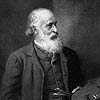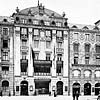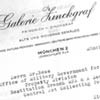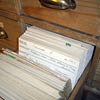History of the Galerie Heinemann
 Founding and Importance
Founding and Importance
The Galerie Heinemann was founded in 1872 by David Heinemann (1819-1902) and was numbered amongst the most important art dealerships in Germany until its "Aryanization" in 1938. In Munich its rooms were originally located at Promenadeplatz, later they were moved to the Prinzregentenstraße and as of 1902 to Lenbachplatz 5/6. The gallery, which operates internationally, had several branch offices in cities such as Frankfurt am Main, Nice and New York. It specialized in 19th and early 20th century German art, but also dedicated itself to English, French and Spanish art. Altogether it organized approximately 300 solo and thematic group exhibitions between 1880 and 1935.
 The heyday of the gallery – 1890 to 1938
The heyday of the gallery – 1890 to 1938
In 1890 the three sons of the art dealer David Heinemann took over the gallery. Theobald and Hermann headed the Munich business; Theodor, the oldest brother, was in charge of the New York office. After the death of the two younger brothers (1919 and 1929, resp.) Theobald Heinemann's widow, Franziska Heinemann (1882-1940), managed the gallery with her son Fritz (1905-1983) until it was "aryanized" at the end of 1939. Fritz Heinemann had already left the parents' art dealership in January of 1938. In May 1938 he emigrated via Switzerland to the USA. His mother followed him to the USA in February 1939, where she died in November 1940.
 Under the direction of Friedrich Heinrich Zinckgraf as of 1938
Under the direction of Friedrich Heinrich Zinckgraf as of 1938
In September 1938 Friedrich Heinrich Zinckgraf (1878-1954), a senior employee of the gallery, took over Fritz Heinemann's share in the gallery. After the pogrom on November 9/10, 1938, Franziska Heinemann's share was also "aryanized" by Zinckgraf. The Aryanization negotiations, however, took a good year at the Chamber of Industry and Commerce in Munich, because Zinckgraf was accused of "fictitious Aryanization" owing to his close contact to the Heinemann family. To finance the business, Zinckgraf finally received a loan from Reich Minister Hjalmar Schacht.
He became the sole owner of the gallery with all its documents by the end of 1939. The business was valued at 220,000 Reichsmark, the stock at 200,000 Reichsmark. Zinckgraf changed the name of the Galerie Heinemann to Galerie Zinckgraf in May 1941 and continued to manage it in unmodified form even after the war (his licence was renewed in September 1946). He even retained the numbering system of the Galerie Heinemann.
 What happened to the gallery documents after the end of the war?
What happened to the gallery documents after the end of the war?
In June 1946 Fritz Heinemann returned to Munich. He probably did not receive the documents of the Galerie Heinemann until after Zinckgraf's death in 1954. Under the name of his wife Christel he once again became active as an art dealer from 1955 to 1957.
In 1972 he turned the business records and card indexes over to the Deutsches Kunstarchiv in the Germanisches Nationalmuseum in Nuremberg (formerly Archiv für Bildende Kunst). At the same time some of the photo cards and the catalogs of the Galerie Heinemann were transferred to the Zentralinstitut für Kunstgeschichte in Munich.
